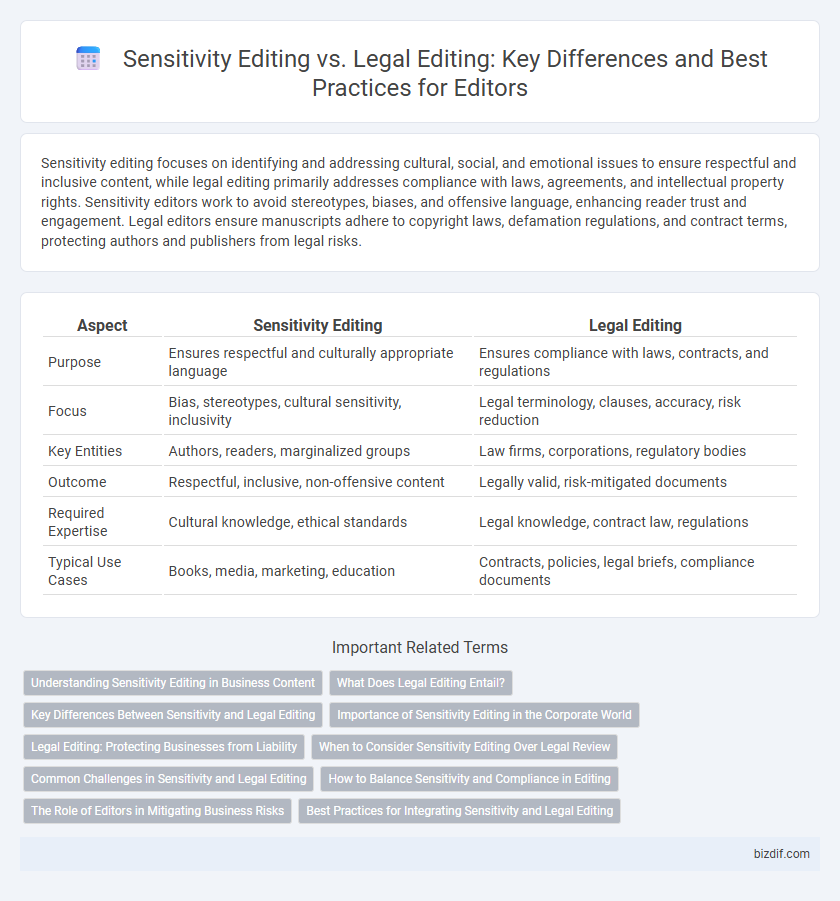Sensitivity editing focuses on identifying and addressing cultural, social, and emotional issues to ensure respectful and inclusive content, while legal editing primarily addresses compliance with laws, agreements, and intellectual property rights. Sensitivity editors work to avoid stereotypes, biases, and offensive language, enhancing reader trust and engagement. Legal editors ensure manuscripts adhere to copyright laws, defamation regulations, and contract terms, protecting authors and publishers from legal risks.
Table of Comparison
| Aspect | Sensitivity Editing | Legal Editing |
|---|---|---|
| Purpose | Ensures respectful and culturally appropriate language | Ensures compliance with laws, contracts, and regulations |
| Focus | Bias, stereotypes, cultural sensitivity, inclusivity | Legal terminology, clauses, accuracy, risk reduction |
| Key Entities | Authors, readers, marginalized groups | Law firms, corporations, regulatory bodies |
| Outcome | Respectful, inclusive, non-offensive content | Legally valid, risk-mitigated documents |
| Required Expertise | Cultural knowledge, ethical standards | Legal knowledge, contract law, regulations |
| Typical Use Cases | Books, media, marketing, education | Contracts, policies, legal briefs, compliance documents |
Understanding Sensitivity Editing in Business Content
Sensitivity editing in business content involves reviewing language and narratives to avoid biases, stereotypes, and cultural insensitivity that could harm brand reputation or alienate stakeholders. It ensures inclusive communication by addressing diverse audiences with respect and accuracy, which is critical for maintaining ethical standards and fostering positive customer relationships. Unlike legal editing, which focuses on compliance and contractual accuracy, sensitivity editing aims to enhance the overall tone and cultural relevance of the material.
What Does Legal Editing Entail?
Legal editing involves ensuring documents comply with relevant laws and regulations while maintaining clarity and precision in language. Editors verify the accuracy of legal terms, correct formatting according to legal standards, and review citations for proper referencing. This process minimizes risk by preventing misinterpretations and enhancing the document's overall credibility.
Key Differences Between Sensitivity and Legal Editing
Sensitivity editing prioritizes cultural accuracy, inclusivity, and the respectful representation of diverse groups, ensuring content avoids stereotypes and biases. Legal editing focuses on compliance with laws, contractual terms, and intellectual property rights, emphasizing clarity and enforceability. The key difference lies in sensitivity editing addressing ethical and social considerations, while legal editing ensures legal precision and risk mitigation.
Importance of Sensitivity Editing in the Corporate World
Sensitivity editing plays a crucial role in the corporate world by ensuring content is respectful, inclusive, and free from bias, which helps protect brand reputation and fosters a positive workplace culture. Unlike legal editing, which focuses on compliance with laws and regulations, sensitivity editing addresses cultural nuances and potential stereotypes that can alienate diverse audiences or cause public relations issues. Prioritizing sensitivity editing enhances communication effectiveness, supports corporate social responsibility initiatives, and reduces the risk of litigation related to discrimination claims.
Legal Editing: Protecting Businesses from Liability
Legal editing ensures that business documents comply with relevant laws and regulations, reducing the risk of legal disputes and potential liabilities. This specialized editing focuses on clarity, accuracy, and adherence to contractual terms to protect companies from costly lawsuits and regulatory penalties. By meticulously reviewing contracts, policies, and disclosures, legal editing safeguards a business's legal interests and supports risk management strategies.
When to Consider Sensitivity Editing Over Legal Review
Sensitivity editing should be prioritized when the content involves cultural, racial, or social issues that could impact diverse audiences or perpetuate stereotypes. Legal review is essential for compliance, contracts, and liability issues, but it does not address the nuances of respectful and inclusive language. Choose sensitivity editing over legal review to ensure the material is ethically sound and resonates positively with marginalized or sensitive groups.
Common Challenges in Sensitivity and Legal Editing
Sensitivity editing faces challenges like interpreting diverse cultural nuances and avoiding inadvertent bias while ensuring respectful representation, requiring deep understanding of social contexts. Legal editing must navigate complex terminology, strict regulatory compliance, and contract precision, where even minor errors can lead to significant liabilities. Both editing types demand meticulous attention to detail and specialized knowledge to balance clarity, accuracy, and ethical considerations.
How to Balance Sensitivity and Compliance in Editing
Balancing sensitivity and compliance in editing requires a careful understanding of both ethical considerations and legal mandates related to content. Sensitivity editing focuses on respecting cultural, social, and emotional impact by avoiding stereotypes and offensive language, while legal editing ensures adherence to copyright laws, defamation, privacy rights, and regulatory standards. Effective editors collaborate with authors and legal advisors to create content that is both inclusive and compliant, thereby minimizing risks while maintaining authenticity and respect for all audiences.
The Role of Editors in Mitigating Business Risks
Sensitivity editing involves reviewing content to ensure cultural accuracy and prevent offense, reducing reputational damage for businesses. Legal editing focuses on identifying potential legal issues such as libel, copyright infringement, and contract ambiguities to avoid litigation risks. Editors play a crucial role in mitigating business risks by applying both sensitivity and legal editing to create content that is respectful, compliant, and legally sound.
Best Practices for Integrating Sensitivity and Legal Editing
Implementing best practices for integrating sensitivity editing with legal editing requires a collaborative approach that prioritizes both cultural accuracy and legal compliance. Editors should develop clear guidelines that incorporate sensitivity readers' insights alongside legal expertise to ensure content is respectful and free from potential liabilities. Leveraging specialized training and cross-disciplinary communication enhances the effectiveness of this integrated editing process, resulting in polished, responsible material.
Sensitivity Editing vs Legal Editing Infographic

 bizdif.com
bizdif.com